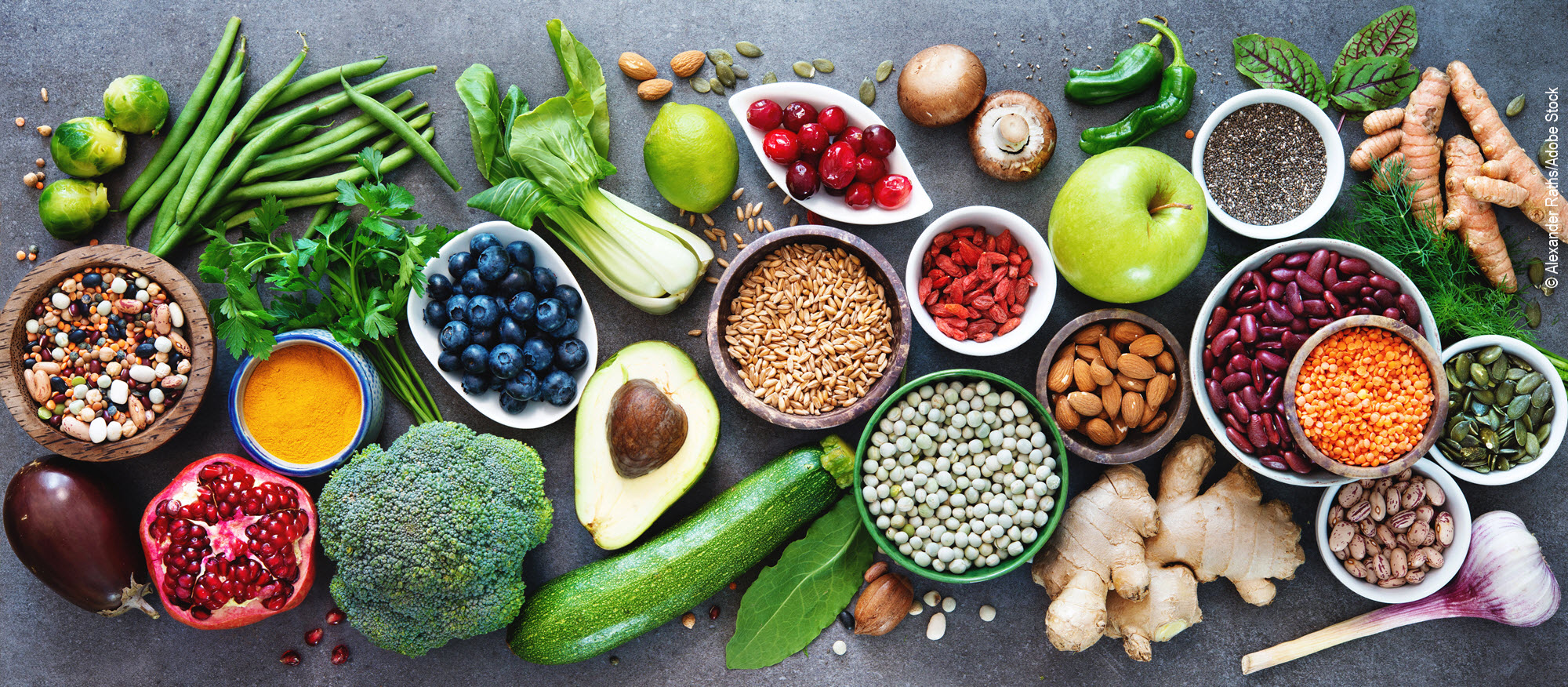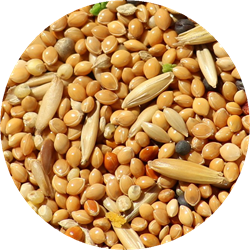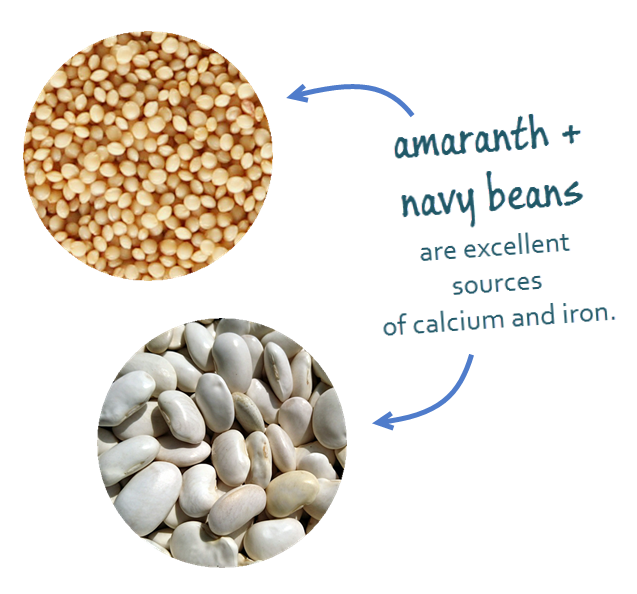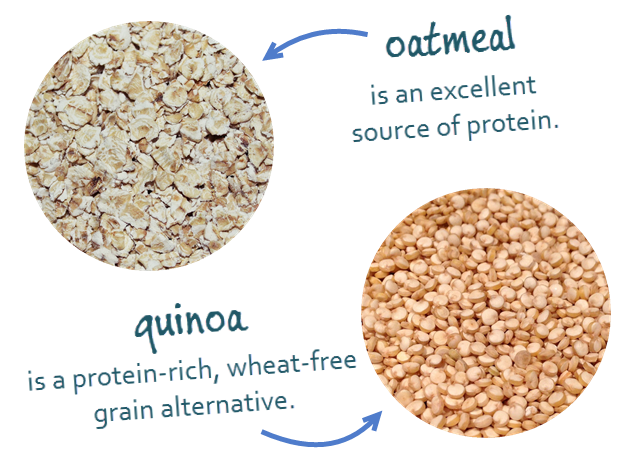Nutrition

Let’s get into the practical aspects of living and eating as a vegan. In the coming pages, we will offer an in-depth look at vegan nutrition, along with an abundance of healthy and flavorful recipes.
Nutrition
What is a vegan diet?
A vegan diet is one that consists only of plant-derived foods. Like non-vegans, vegans eat soups, stews, stir-fries, salads, and casseroles. They consume a wide variety of foods from around the globe, as well as plant-only versions of traditional favorites such as pizza, tacos, burritos, lasagna, burgers, barbecues, loaves, chilis, pancakes, sandwiches, and desserts.
What is a healthy vegan diet?
As indicated earlier in this booklet, the Academy of Nutrition and Dietetics states that a well-planned vegan diet is healthy for all stages of life. They further advise that plant-based diets may provide a variety of preventative health benefits. Of course, as with any diet, a poorly planned vegan diet could be dangerous or unhealthy.
Demystifying
vegan nutrition
This section has been adapted from the IVA’s Demystifying Vegan Nutrition document, which was developed in consultation with Dina Aronson, MS, RD. The original document, complete with footnotes and some expanded sections, is available at the IVA website (internationalvegan.org).
A balanced vegan diet is made up of these four food groups: 1) legumes, nuts, and seeds; 2) grains; 3) vegetables; and 4) fruits.

legumes, nuts & seeds

grains

vegetables

fruits
This information is provided for educational purposes only. It is not intended as a substitute for advice from a healthcare professional. Persons with medical conditions or who are taking medications should discuss diet and lifestyle changes with their healthcare professional.
Because individual nutrient needs and energy requirements vary due to age, activity level, and one’s state of health, this guide should only be considered a broad blueprint for a balanced vegan diet. You should consult a dietitian familiar with vegan nutrition for a personalized set of recommendations.
LEGUMES, NUTS, AND SEEDS (4+ servings per day)
The legume-nut-seed group includes beans, split peas, lentils, nuts, seeds, and soy products. These nutrient-dense foods are packed with protein, fiber, minerals, B vitamins, protective antioxidants, and essential fatty acids. Sample serving sizes from this group include: 1/2 cup of cooked beans, 4 ounces of tofu or tempeh, 1 cup of soy milk, 1 ounce of nuts or seeds, or 2 tablespoons of nut or seed butter.
GRAINS (4-6+ servings per day)
Whole grains provide B vitamins, fiber, minerals, protein, and antioxidants. They are preferable to refined grains because the refining process removes the healthiest nutrients. Also, intact whole grains—such as brown rice, oats, wheat berries, millet, and quinoa—are nutritionally superior to whole grain flours and puffed or flaked whole grains. A serving is 1 slice of bread, 1/2 cup of cooked grain, or 1 ounce of ready-to-eat cereal. This group is fairly flexible with regard to servings per day. Vary your intake based on your individual energy needs.
Oils and spreads
Concentrated fats, such as oils and oil-based spreads, do not fall under a food group. They are not required for optimal health, as essential fats are found naturally in whole foods like avocados, olives, nuts, and seeds, and for that reason there is no serving recommendation. However, a small amount of concentrated fats may be included in a healthy vegan diet. Choose oils and spreads that are minimally processed and limit your intake.
VEGETABLES (4+ servings per day)
Eating a wide variety of colorful vegetables every day will ensure that you’re getting an assortment of protective nutrients in your diet. A vegetable serving is 1/2 cup cooked, 1 cup raw, or 1/2 cup of juice. For most vegetables, particularly calcium-rich leafy greens, it’s nearly impossible to eat “too much.”
FRUITS (2+ servings per day)
Most fruits, especially citrus fruits and berries, are a great source of vitamin C. All fruits provide antioxidants. Choose whole fruits over fruit juices to get the most benefit, particularly from dietary fiber. A serving size is 1 medium piece, 1 cup sliced, 1/4 cup dried, or 1/2 cup of juice.
Important Nutrients
Like non-vegans, vegans need to be mindful of consuming all the nutrients they need in order to be healthy. Four key nutrients that everyone needs to pay attention to are vitamin B12, vitamin D, omega-3 fatty acids, and iodine. After discussing these four nutrients, we will also look at calcium, iron, and protein.
B12
Be advised that some B12 vitamins labeled as “vegetarian” are not suitable for vegans. In general, it is worth keeping in mind that many vitamins and supplements contain animal products.
VITAMIN B12 is necessary for proper red blood cell formation, neurological function, and DNA synthesis. It is manufactured by certain types of bacteria found in nature. Because plants vary widely in their levels of this bacteria (and most of us favor our food scrubbed squeaky clean), we cannot rely on plant foods to meet our B12 needs. We can ensure our dietary needs are met by consuming supplements or fortified foods.
Our suggestion for teens and adults into their early sixties is to supplement with a vegan source of B12, either 100 micrograms (mcg) per day or 1000 mcg twice a week. Due to decreased absorption, people over 65 are advised to supplement with 500-1000 mcg daily, while we suggest toddlers get 10-20 mcg per day and pre-teens get about 20-40 mcg or so daily. If you prefer not to use supplements, consume multiple servings of a variety of vitamin B12-fortified food throughout the day.
VITAMIN D, the “sunshine vitamin,” is also a hormone; our skin manufactures it from the ultraviolet rays of the sun. It plays an important role in bone health and supports normal neuromuscular and immune function. Good vitamin D status is linked to a lowered risk of osteoporosis, certain cancers, and other chronic diseases. Getting enough of it is not as easy as we may think. Vitamin D blood levels are an international public health concern.
The body’s ability to produce vitamin D from sun exposure varies based on skin pigmentation, sunscreen, clothing, time of year, latitude, air pollution, and other factors, and the vitamin is found naturally in only a handful of foods. This is why all people—not just vegans—need to be mindful about vitamin D.
The latest research suggests that even getting 100% of the current Recommended Dietary Allowance (RDA) for vitamin D may be insufficient for many people. To ensure adequate vitamin D intake, take 1000-4000 International Units (IU) per day, depending upon your age and other individual needs.
“All people–not just vegans–need to be mindful about vitamin D.”
Supplemental vitamin D can be found as either D2 or D3. D2 (ergocalciferol) is derived from non-animal sources, while D3 (cholecalciferol) is commonly derived from lanolin, a protective waxy substance secreted by sheep. More recently, plantbased D3 has come to market. If you can’t find vegan D3, D2 is just fine for supplementing daily.
To determine your vitamin D status, schedule a 25(OH)D (25-hydroxyvitamin D) blood test at your next medical checkup. Your healthcare provider can offer supplement guidelines based on the results.
OMEGA-3 FATTY ACIDS. A proper balance of essential fats is important for optimal brain function, heart health, and infant/child development. Alpha-linolenic acid (ALA) is an omega-3 fatty acid that partly converts to DHA and EPA in the body. It is present in several plant foods, including flax products, hemp products, walnuts, and leafy green vegetables. Aim to consume 2 to 4 grams of ALA per day. If you aren’t sure whether your intake is adequate, you may wish to take up to 300 milligrams of a vegan DHA or DHA-EPA blend per day.
IODINE is a trace element needed by the body to produce thyroid hormones. This makes iodine important to the metabolism and other vital bodily functions, including bone and brain development during pregnancy and infancy. Inadequate iodine intake causes insufficient thyroid hormone production, which can in turn cause a number of health problems, including an enlargement of the thyroid gland, called goiter, as well as issues with fetal and infant development and an autoimmune disease of the thyroid.
The few small studies that have examined the iodine status of vegans have found that they may be at greater risk for low iodine intake than the general population. That being said, iodine deficiency is a global public health concern, affecting an estimated 2 billion people, a third of whom are children.
There is generally very little iodine in food. However, not much iodine is needed in one’s diet, so the daily recommended amount is not difficult to get. The most potent food sources of iodine are sea vegetables, though the amount of iodine can vary widely depending on environmental conditions, species, season of harvest, and age of the plant.
| Omega-3 fatty acids | |
|---|---|
| Food, serving size | ALA (grams) |
| Flax seed whole, 2 tbsp | 5.2 |
| Flax seed ground, 2 tbsp | 3.8 |
| Flax seed oil, 1 tsp | 2.7 |
| Walnuts, 1 oz (1/4 cup) | 2.6 |
| Hemp seed oil, 1 tsp | 0.9 |
| Tofu firm, 1/2 cup | 0.7 |
| Canola oil, 1 tsp | 0.5 |
| Greens (mixed), 2 cups | 0.2 |

A serving of kelp or kombu can easily provide several times one’s daily requirement, while a gram of dulse may contain 100% of the requirement. Apart from foods, iodized salt consumption is one of the consistent ways to reach one’s daily iodine requirement.
CALCIUM is naturally widespread in the plant kingdom, and so our calcium needs can be met with whole plant foods (and, optionally, calcium-fortified foods). Adults need about 1000 milligrams per day, though the amount depends on one’s stage in the lifecycle. We recommend choosing several calcium-rich foods in each food group each day. Plants rich with calcium include leafy green vegetables, beans, sesame seeds, figs, and almonds.
IRON is a mineral used by the body to carry oxygen from our lungs to the rest of the body, among other functions. When one does not get enough iron, it can lead to fatigue, cognitive impairment, and other health problems. While the National Institutes of Health (in the United States) does not list vegans as one of the groups at risk for iron deficiency in its dietary supplement fact sheet on iron, many vegans may naturally fall into one of the groups that are at risk, including pregnant women, infants, and children. It’s a good idea to be aware of maintaining an iron intake generally suited to your age and activity level.
| Calcium | |
|---|---|
| Food, serving size | Calcium (mg) |
| Fortified orange juice, 1 cup | 300-350 |
| Amaranth, 1 cup (cooked) | 275 |
| Collard greens, 1 cup (cooked) | 270-360 |
| Broccoli rabe/rapini, 1/2 bunch (cooked) | 260 |
| Fortified soy milk, 1 cup | 200-370 |
| Sesame seeds (unhulled), 2 tbsp | 175 |
| Navy beans, 1 cup (cooked) | 160 |
| Bok choy, 1 cup (cooked) | 160 |
| Soy yogurt, 1 cup | 150-350 |
| Calcium-set tofu, 1/2 cup | 140-420 |
| Figs, 5 large (raw) | 110 |
| Blackstrap molasses, 1 tbsp | 80-170 |
| Almonds, 1 oz | 70 |

| Iron | |
|---|---|
| Food, serving size | Iron (mg) |
| Soybeans, mature, 1/2 cup (cooked) | 4.4 |
| White beans, 1/2 cup (cooked) | 3.3 |
| Lentils, 1/2 cup (cooked) | 3.3 |
| Spinach, 1/2 cup (cooked from fresh) | 3.2 |
| Amaranth, 1/2 cup (cooked) | 2.6 |
| Chickpeas, 1/2 cup (cooked) | 2.4 |
| Dark chocolate, 45%-59% cacao solids, 1 oz | 2.3 |
| Soybeans, green, 1/2 cup (cooked) | 2.3 |
| Pumpkin and squash seed kernels, 1 oz (roasted) | 2.3 |
| Navy beans, 1/2 cup (cooked) | 2.2 |
| Refried beans, canned, 1/2 cup | 2.1 |
| Kidney beans, 1/2 cup (cooked) | 2 |
| Cashew nuts, 1 oz (raw) | 1.9 |
| Black beans, 1/2 cup (cooked) | 1.8 |
| Blackstrap molasses, 1 tbsp | 0.9 |
| RDAs for Iron | ||
|---|---|---|
| Group | Age | Iron (mg/day) |
| Infants | 0-6 months | 0.27* |
| 7-12 months | 11 | |
| Children | 1-3 years | 7 |
| 4-8 years | 10 | |
| Men | 9-13 years | 8 |
| 14-18 years | 11 | |
| 19 and up | 8 | |
| Women | 9-13 years | 8 |
| 14-18 years | 15 | |
| 19-50 years | 18 | |
| 51+ years | 8 | |
| Pregnant Women | 14-50 years | 27 |
| Lactating Women | 14-18 years | 10 |
| 19-50 years | 9 | |
Iron intake can be improved by avoiding foods that inhibit iron absorption and through thoughtful food preparation. For example, iron absorption is inhibited when calcium supplements, coffee, and black and green tea are consumed along with foods containing iron. To increase iron absorption at meals, prepare high-iron foods like beans with foods high in vitamin C, such as citrus fruits, bell peppers, and leafy green vegetables. Cooking acidic foods (e.g., tomatoes) in a cast iron skillet can also improve the iron content of your meal.
PROTEIN contributes to healthy muscles and bones, tissue repair, a healthy immune system, and more. Because 10-20% of calories in most plant foods (legumes, vegetables, and grains especially) are from protein, and humans need only about 10-15% of their calories from protein, requirements are easily met with a diet consisting of a variety of whole plant foods.
The RDA for protein is dependent upon a person’s age and sex. Pregnancy, activity level, and health status also affect your needs. However, to get a general sense of what your daily protein intake should be in grams, take your weight in pounds and multiply it by 0.36. For example, a 150-pound (68-kilogram) adult should consume about 55 grams of protein per day.
The following sample meal plan easily surpasses that target, at 77 grams of protein:
Breakfast
1 1/2 cups oatmeal topped with
1 oz walnuts
1 small banana
Lunch
1 1/2 cups three-bean chili
1 piece jalapeño cornbread
2 cups southwestern vegetable salad
Dinner
2 cups stir-fried sweet potato, onion, bok choy, and broccoli
4 oz sesame orange baked tofu
2 cups brown rice
Snacks
2 tbsp peanut butter on whole grain crackers and fruit
2 oz trail mix

Plant proteins
Despite a common myth, it is not necessary to “complement” plant proteins at mealtime. The human body stores amino acids, the building blocks of protein, so that complete proteins can be manufactured in the body over time.
A Few Lingering Questions
Don’t I need some cholesterol?
Vegan diets are 100% cholesterol-free and this is 100% fine. There is no RDA for cholesterol because it is not an essential nutrient. The body (specifically the liver) manufactures all the cholesterol a person needs to be healthy.
What about my food allergies?
There are numerous healthy grain alternatives for vegans with a wheat allergy or gluten intolerance. In fact, many grains are nutritionally superior to wheat, including millet. Quinoa, a seed, is also an excellent grain alternative. Products that were once only available in wheat varieties (e.g., bread and crackers) are now available wheat- and gluten-free. A soy allergy is very workable, as soybeans are just one food. Soy-based meat analogs can be replaced with nut- or wheatbased varieties (such as seitan). Nut allergies are usually isolated; few people are allergic to all nuts and seeds. Testing can determine which nuts and seeds are safe. Substitutions usually work well in recipes and in foods such as granola, trail mix, and nut/seed butters.
Soy: too much of a good thing?
Many new vegans enjoy soy products that mimic the flavors and textures of meat and dairy products. Is it possible to consume too much soy? Yes, it is, just as it’s possible to eat too much of many kinds of foods. Eating too many processed soy products means that other foods are being displaced, which throws off a healthy balance of foods. A reasonable daily limit of processed soy products is two servings per day. Soy products are healthiest when they are fermented or otherwise minimally processed. Examples include edamame, miso, tempeh, tofu, and fortified soymilk made from whole organic soybeans.
I tried a vegan diet and felt unhealthy. What did I do wrong?
Sometimes when we make positive changes to our diet—such as eliminating animal products or replacing processed junk food with whole plant foods—we may encounter some temporary bodily complaints, including cravings, fatigue, or digestive discomfort. These are not uncommon during a major dietary transition, especially if fiber intake increases dramatically in a short period of time. If symptoms continue for more than two to three days, you may want to see a doctor to rule out coincidental health conditions.
Sometimes a well-intentioned change to eating vegan can backfire when the diet is not properly balanced. One common mistake when transitioning to a vegan diet is eating too few calories. Healthy vegan diets tend to be big on volume—your plate should be overflowing with fresh food, especially when you include lots of raw vegetables. If you continue eating only the same volume of food as before, you might not get enough calories, leaving you tired, hungry, and irritable.
“Healthy vegan diets tend to be big on volume.”
Another common mistake is simply replacing meat with meat analogs, dairy products with soy-based alternatives, and regular sweets with vegan sweets. Going heavy on these items and light on the vegetables, fruits, and whole grains is not a healthy approach. To learn how to best reap the benefits of a healthy vegan diet, sign up for a vegan nutrition or cooking class, or pick up a reliable book on vegan nutrition, such as Becoming Vegan, by Brenda Davis and Vesanto Melina.
This page is a reproduction of a section of the booklet Vegan Starter Kit: Respecting Animals Means Going Vegan published by the International Vegan Association. Images and formats might differs from the original booklet.
The arguments and ideas in the booklet are based on the work of Prof. Gary L. Francione. Learn more at abolitionistapproach.com and howdoigovegan.com.
The Vegan Starter Kit: Respecting Animals Means Going Vegan booklet is published by the International Vegan Association. Readers are welcome to reproduce articles from the original publication in their entirety and with attribution for personal or educational use without additional permission. Material may not be reproduced for resale without prior arrangement with the IVA. © International Vegan Association, 2017. For additional resources or to contact the IVA, visit internationalvegan.org.
The booklet is licensed under a Creative Commons Attribution-NonCommercial-NoDerivatives 4.0 International License. ![]()
